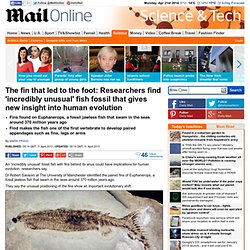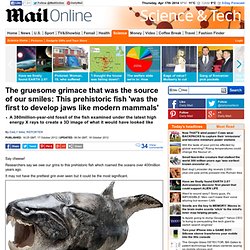

Devonian Period, Age of Fishes Information, Prehistoric Facts. The fin that led to the foot: Researchers find fossils showing fish evolving. Fins found on Euphanerops, a fossil jawless fish that swam in the seas around 370 million years agoFind makes the fish one of the first vertebrate to develop paired appendages such as fins, legs or arms By Mark Prigg Published: 09:14 GMT, 11 April 2013 | Updated: 09:14 GMT, 11 April 2013 An 'incredibly unusual' fossil fish with fins behind its anus could have implications for human evolution, researchers say.

Dr Robert Sansom at The University of Manchester identified the paired fins of Euphanerops, a fossil jawless fish that swam in the seas around 370 million years ago. They say the unusual positioning of the fins show an important evolutionary shift. Euphanerops with the anal fins visible near the tail. Euphanerops, a fossil jawless fish that swam in the seas around 370 million years ago. The Euphanerops fish were 3.9 inches (10 centimeters) long and looked somewhat like modern-day eels. As such, it represents an important stage in the evolution of paired appendages.' The gruesome grimace that was the source of our smiles: This prehistoric fish 'was the first to develop jaws like modern mammals'
A 380million-year-old fossil of the fish examined under the latest high energy X rays to create a 3D image of what it would have looked like By Daily Mail Reporter Published: 16:25 GMT, 17 October 2012 | Updated: 06:54 GMT, 18 October 2012 Say cheese!

Researchers say we owe our grins to this prehistoric fish which roamed the oceans over 400million years ago. It may not have the prettiest grin ever seen but it could be the most significant. What a grim grin: The gruesome gnashers of the Compagopiscis suggests humans may have developed working teeth and jaws much earlier than previously suspected. Re-created from clay: The spiky mollusc which last crawled the shores of Earth 390million years ago. Mollusc brought back to life thanks to CT scans and 3D printing By Eddie Wrenn Published: 08:14 GMT, 20 September 2012 | Updated: 08:24 GMT, 20 September 2012 From the looks of it, this is a mollusc you would not wish to step on with your bare feet at the beach.

Luckily, humans and this spine-covered 'multiplacophoran' never crossed paths, as the creature last lived 390 million years ago. But what you see here is a reconstruction by a University of Texas and Brown University collaboration, using the latest 'micro CT' scanning techniques as well as a 3D printer to create a clay replica of the mollusc. The model is part of a range of research aiming to pinpoint the origins and relations of the mollusc, which was only discovered in the last decade. Sharp corners: The model of the multiplacophoran was created out of clay based on a 3D printer cast by the University of Texas and Brown University The team's life-like model was brought to life by a mix of old and new technology.